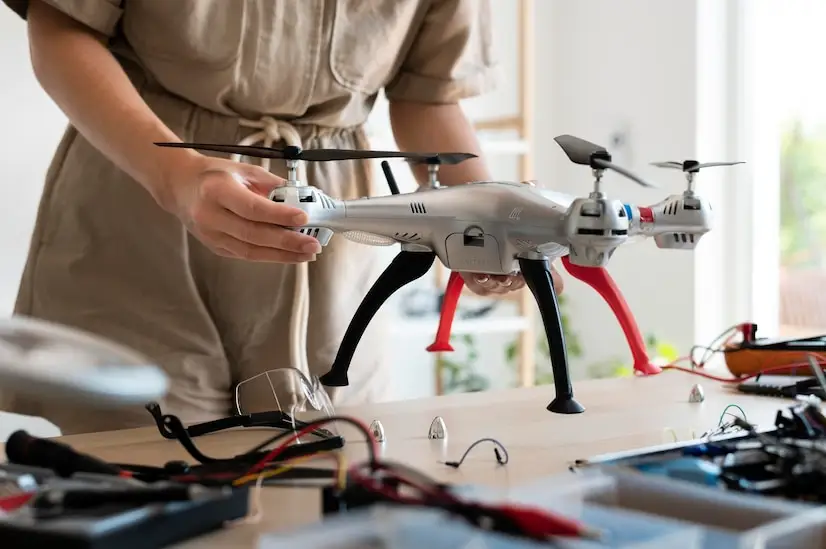“`html
How to Build FPV Drones in India
What: This article explains a step by step guide to building FPV drones in India.
Why: This article’s objective is to guide people in exploring all available options for building FPV drones in India.
An FPV drone, or a First Person View drone, is a radio-controlled drone equipped with a camera that provides a real-time video feed to the pilot. India is not an exception to the global trend of enthusiasts taking an interest in FPV drones.
Building FPV drones from the bottom up is becoming more and more popular as technology develops and the drone community grows. You can make your very own FPV drone by following the instructions in this article.
Drone parts: Choosing the RIGHT components
Before starting to make an FPV drone, you must gather the necessary equipment. You can get by with just a few simple tools when you first start.
This section contains detailed lists of every part that builds up the drone.
- Drone Frame
- Motors
- ESC (Electronic Speed Controller)
- Flight Controller
- Transmitter and Receiver
- Propellers
- Propeller Guards
- Batteries
How to Build an FPV Drone: Step-by-Step Guide
- Assembling the Frame – Lay out all of the frame components to determine the standoffs, arms, and base plate. Assemble the frame securely by following the manufacturer’s guide. Make sure that the frame is strong and that all the screws are tight.
- Mounting the PDB (Power Distribution Board) – Install the Power Distribution Board into the frame’s centre. Use insulated wires to connect the PDB to the battery terminals.
- Mounting the Motors – Attach the motors to the arms of the frame using the provided screws. Make sure the motors are aligned properly and securely fastened.
- Mounting the ESCs (Electronic Speed Controller) – Mount the ESCs on the arms close to the motors. Secure them with zip ties or heat shrink tubing.
- Connecting the ESCs to the Motors – Use motor wires to connect the ESCs to the motors.
- Connecting the ESCs to the PDB – Connect the ESCs to the Power Distribution Board.
- The First Test!!! – Before proceeding further, power up the drone and test the motors using a transmitter or a dedicated tool.
- Mounting the FPV System – Attach the video transmitter and FPV camera to the frame. To reduce vibrations and possible damage during flights, secure the components.
- Connecting the FPV System – Using the proper wires, connect the FPV camera and video transmitter.
- Test the FPV System – Turn on the drone and give the FPV system a try. Examine the live stream on your monitor or FPV goggles.
- Mounting and Powering the Receiver – Attach the receiver onto the frame, making sure to position the antenna correctly. Connect the receiver to the Power Distribution Board and bind it to your transmitter.
- Wiring the Flight Controller – Connect the flight controller to the PDB, ESCs, and receiver.
- Completing the Build – Double-check all connections, secure loose components, and make sure there are no exposed wires.
- Software Configuration – Install the necessary firmware on the flight controller.
- Final Test – Perform a final test by arming the drone and checking motor responses.
Common Problems and Their Solutions
Some of the major problems faced while flying drones are listed below, along with their solutions:
- The props are often in the frame
- The screen’s transmission is not smooth
- Blocked GPS signals
- Abnormal flight direction
- UAV signal lost
- The drone battery problem
Benefits of Making Own Drone
Constructing your drone allows for fine customization to match your preferences and budget. This also offers significant cost savings. Purchasing individual parts guarantees cost-effectiveness by removing unwanted features.
Complete customisation is possible when you build your drone, since you may modify the frame, motor, camera, and sensors to suit your requirements.
In-depth knowledge of drone technology can be gained by taking part in a self-project.
Making your own FPV drone in India is essentially like setting out on a customised, low-cost journey. It helps you to get an in-depth knowledge of drone technology. This detailed guide simplifies the procedure, helping you overcome obstacles and gain an understanding of drone technology. It is a hands-on experience that improves your troubleshooting abilities. It keeps you informed of the most recent innovations and is not just about owning a personalised drone. According to experts…
“`
